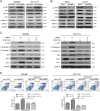Nuclear receptor binding protein 1 correlates with better prognosis and induces caspase-dependent intrinsic apoptosis through the JNK signalling pathway in colorectal cancer
- PMID: 29567997
- PMCID: PMC5864759
- DOI: 10.1038/s41419-018-0402-7
Nuclear receptor binding protein 1 correlates with better prognosis and induces caspase-dependent intrinsic apoptosis through the JNK signalling pathway in colorectal cancer
Abstract
Nuclear receptor binding protein 1 (NRBP1) is a ubiquitously expressed and highly conserved pseudokinase that has important roles in cellular homoeostasis. Despite recent advances in understanding the biology of NRBP1, the role of NRBP1 and its underlying mechanism in colorectal cancer (CRC) have not been fully elucidated. In the present study, we observed that NRBP1 expression levels were significantly reduced in CRC tissues compared with corresponding adjacent normal tissues, and high NRBP1 expression correlated with better prognosis in CRC. Overexpression of NRBP1 inhibited CRC cell proliferation and promoted apoptosis in vitro and in vivo. In contrast, knockdown of NRBP1 expression increased cell proliferation and decreased the percentage of apoptotic cells. Moreover, overexpression of NRBP1 activated caspase-dependent intrinsic apoptosis. In addition, we further discovered that NRBP1 regulated the apoptotic pathway through interaction with JNK. Finally, NRBP1 overexpression led to attenuated CRC growth in a xenograft mouse model. Our study illustrates the suppressor role of NRBP1 in CRC and provides a potential therapeutic target.
Conflict of interest statement
The authors declare that they have no conflict of interest.
Figures







Similar articles
-
High NRBP1 expression in prostate cancer is linked with poor clinical outcomes and increased cancer cell growth.Prostate. 2012 Nov;72(15):1678-87. doi: 10.1002/pros.22521. Epub 2012 Apr 2. Prostate. 2012. PMID: 22473923
-
Hepatocyte nuclear factor 4 gamma (HNF4G) is correlated with poor prognosis and promotes tumor cell growth by inhibiting caspase-dependent intrinsic apoptosis in colorectal cancer.Eur J Pharmacol. 2022 Feb 5;916:174727. doi: 10.1016/j.ejphar.2021.174727. Epub 2021 Dec 26. Eur J Pharmacol. 2022. PMID: 34965388
-
SRGN Promotes Colorectal Cancer Metastasis as a Critical Downstream Target of HIF-1α.Cell Physiol Biochem. 2018;48(6):2429-2440. doi: 10.1159/000492657. Epub 2018 Aug 17. Cell Physiol Biochem. 2018. PMID: 30121667
-
The pseudokinase NRBP1 activates Rac1/Cdc42 via P-Rex1 to drive oncogenic signalling in triple-negative breast cancer.Oncogene. 2023 Mar;42(11):833-847. doi: 10.1038/s41388-023-02594-w. Epub 2023 Jan 24. Oncogene. 2023. PMID: 36693952 Free PMC article.
-
Silencing of Girdin suppresses the malignant behavior of colorectal carcinoma cells.Oncol Rep. 2018 Aug;40(2):887-894. doi: 10.3892/or.2018.6511. Epub 2018 Jun 20. Oncol Rep. 2018. PMID: 29989653
Cited by
-
NRBP1 and TSC22D proteins affect distal convoluted tubule physiology through modulation of the WNK pathway.Sci Adv. 2025 Jul 18;11(29):eadv2083. doi: 10.1126/sciadv.adv2083. Epub 2025 Jul 16. Sci Adv. 2025. PMID: 40668923 Free PMC article.
-
Nuclear Receptor Binding Protein 2 Is Downregulated in Medulloblastoma, and Reduces Tumor Cell Survival upon Overexpression.Cancers (Basel). 2020 Jun 6;12(6):1483. doi: 10.3390/cancers12061483. Cancers (Basel). 2020. PMID: 32517178 Free PMC article.
-
Exploring the Causal Relationship and Molecular Mechanisms Between Fasting Insulin and Androgenetic Alopecia: A Mendelian Randomization Study with Bioinformatics Analysis.Clin Cosmet Investig Dermatol. 2025 Feb 7;18:355-365. doi: 10.2147/CCID.S492958. eCollection 2025. Clin Cosmet Investig Dermatol. 2025. PMID: 39935957 Free PMC article.
-
Bifidobacterium animalis sup F1-7 Acts as an Effective Activator to Regulate Immune Response Via Casepase-3 and Bak of FAS/CD95 Pathway.Probiotics Antimicrob Proteins. 2023 Oct;15(5):1234-1249. doi: 10.1007/s12602-022-09975-9. Epub 2022 Aug 22. Probiotics Antimicrob Proteins. 2023. PMID: 35995910
-
NRBP1 and TSC22D proteins impact distal convoluted tubule physiology through modulation of the WNK pathway.bioRxiv [Preprint]. 2024 Dec 19:2024.12.12.628222. doi: 10.1101/2024.12.12.628222. bioRxiv. 2024. Update in: Sci Adv. 2025 Jul 18;11(29):eadv2083. doi: 10.1126/sciadv.adv2083. PMID: 39764004 Free PMC article. Updated. Preprint.
References
-
- Sun, J., Ding, W., Zhi, J. & Chen, W. MiR-200 suppresses metastases of colorectal cancer through ZEB1. Tumor Biol. 37, 15501–15507 (2016). 10.1007/s13277-015-3822-3. - PubMed
Publication types
MeSH terms
Substances
LinkOut - more resources
Full Text Sources
Other Literature Sources
Medical
Research Materials

